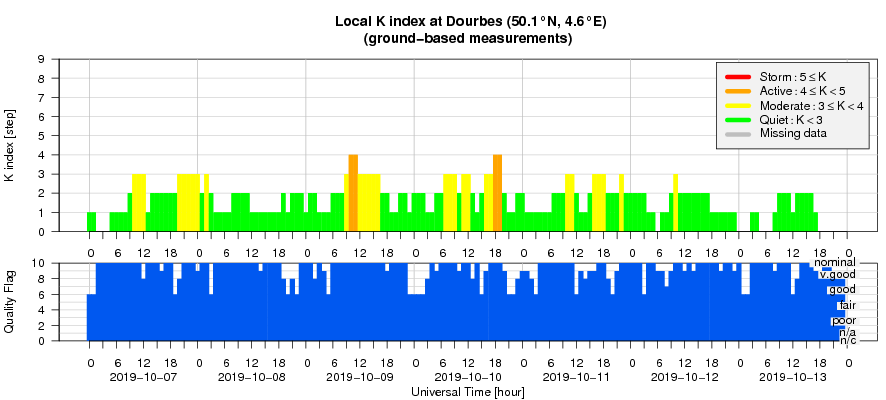- Table of Content
- 1.EUI and Solar ...
- 2.Review of sola...
- 3.PROBA2 Observa...
- 4.The Internatio...
- 5.Geomagnetic Ob...
- 6.The SIDC space...
- 7.Review of iono...
2. Review of solar and geomagnetic activity
3. PROBA2 Observations (7 Oct 2019 - 13 Oct 2019)
4. The International Sunspot Number by SILSO (7 Oct 2019 - 13 Oct 2019)
5. Geomagnetic Observations at Dourbes (7 Oct 2019 - 13 Oct 2019)
6. The SIDC space weather Briefing
7. Review of ionospheric activity (7 Oct 2019 - 13 Oct 2019)
EUI and Solar Orbiter ready for launch
Brussels, 18 October 2019 – Ever closer to the Sun! The instrument EUI (Extreme Ultraviolet Imager) is integrated into the Solar Orbiter satellite to be launched towards the Sun in February 2020. Today, Solar Orbiter can be seen for the last time before being shipped to Cape Canaveral, the launch site.
The ESA Solar Orbiter mission will perform close-up studies of the Sun, from a distance of only 42 million km. That is less than one third of the distance from the Earth to the Sun, and also well within Mercury's orbit. The EUI telescopes will take pictures of the solar atmosphere in non-visible light, i.e. in extreme ultraviolet.
EUI will offer scientists a unique opportunity to have a close look at the dynamic processes in the solar atmosphere. In particular, EUI will image the solar poles for the first time and will provide the sharpest movies ever of the solar atmosphere. This will help us to better understand solar eruptions, which can have severe consequences on our technology such as GPS and radio communication, power grids, and pipelines.
The EUI project started in 2008 under the scientific lead of the Royal Observatory of Belgium and the engineering lead of the Centre Spatial de Liège (Belgium). The Institut d’Astrophysique Spatiale (France) and Max Planck Institute for Solar System Research (Germany) contributed to the telescopes of EUI. The computer of EUI was developed by the Mullard Space Science Laboratory, UK. The Physikalisch-Meteorologisches Observatorium Davos/World Radiation Center (Switzerland) developed the telescope enclosure. The EUI instrument will be managed by the Royal Observatory of Belgium.
David Berghmans, PI after launch: 'The coming month will be so busy but so exciting, not only for me but for the whole team.'
Online press release: http://sidc.be/EUI/popular/lastChance
EUI before being integrated

Artistic view of Solar Orbiter in front of the Sun

Review of solar and geomagnetic activity
SOLAR ACTIVITY
Solar activity was very low. No earth-directed coronal mass ejections (CMEs) have been observed in coronagraphic imagery. The greater than 10 MeV proton flux was at nominal values. A patchy negative polarity coronal hole in the southern solar hemisphere transited the central meridian on 10 October.
GEOMAGNETIC ACTIVITY
The solar wind speed ranged between 320 and 520 km/s (ACE), with the slightly elevated speed on October 10-11. The interplanetary magnetic field (phi angle) was directed mostly away from the Sun (positive sector), except on October 9, when it switched to the negative sector for approximately one day. Bz varied between -9 and +9 nT, with two periods of strong negative Bz on October 9 and 10.
Geomagnetic field was quiet to active, with the active episodes occurring during the enhanced solar wind conditions on October 9 and 10.
PROBA2 Observations (7 Oct 2019 - 13 Oct 2019)
Solar Activity
Solar flare activity remained very low during the week.
In order to view the activity of this week in more detail, we suggest to go to the following website from which all the daily (normal and difference) movies can be accessed: http://proba2.oma.be/ssa
This page also lists the recorded flaring events.
A weekly overview movie can be found here (SWAP week 498): http://proba2.oma.be/swap/data/mpg/movies/weekly_movies/weekly_movie_2019_10_07.mp4
Details about some of this week's events can be found further below.
If any of the linked movies are unavailable they can be found in the P2SC movie repository here: http://proba2.oma.be/swap/data/mpg/movies/
Sunday Oct 13
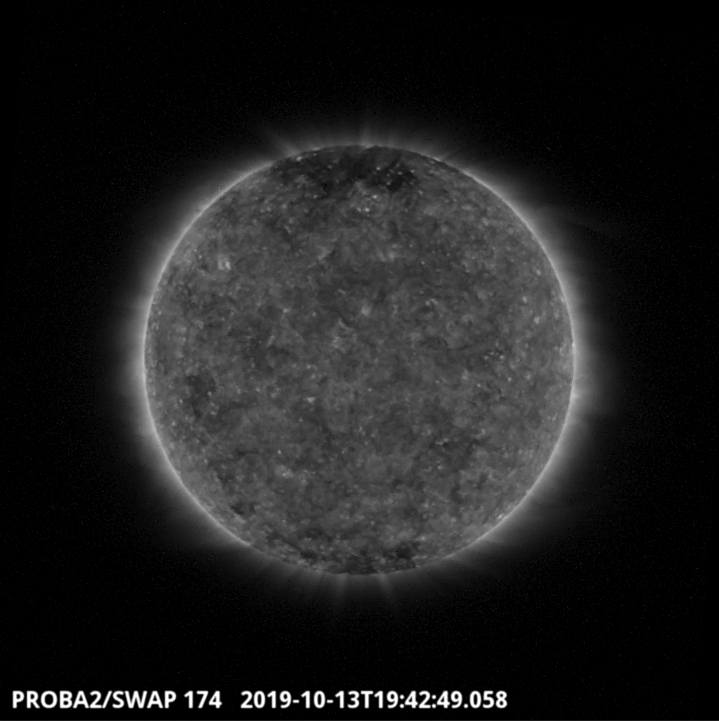
An eruption, originating from the backside of the Sun, was observed by SWAP on 2019-Oct-13 and is shown emerging over the north-west solar limb in the SWAP image above taken at 19:42 UT.
Find a movie showing the event more clearly here (SWAP movie): https://proba2.sidc.be/swap/movies/20191013_swap_movie.mp4
The International Sunspot Number by SILSO (7 Oct 2019 - 13 Oct 2019)
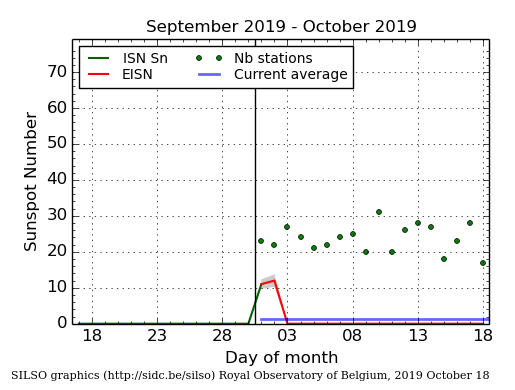
The daily Estimated International Sunspot Number (EISN, red curve with shaded error) derived by a simplified method from real-time data from the worldwide SILSO network. It extends the official Sunspot Number from the full processing of the preceding month (green line). The plot shows the last 30 days (about one solar rotation). The horizontal blue line shows the current monthly average, while the green dots give the number of stations included in the calculation of the EISN for each day.
The SIDC space weather Briefing
The Space Weather Briefing presented by the forecaster on duty from Oct 6 to 13. It reflects in images and graphs what is written in the Solar and Geomagnetic Activity report.
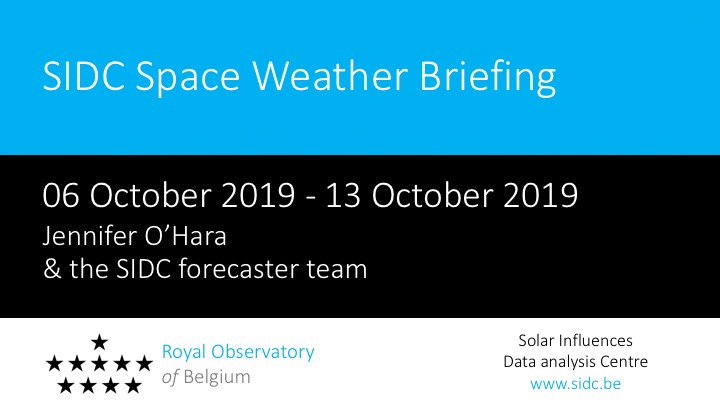
The pdf-version: http://www.stce.be/briefings/20191014_SWbriefing.pdf
The automatically running presentation: http://www.stce.be/briefings/20191014_SWbriefing.ppsm
Review of ionospheric activity (7 Oct 2019 - 13 Oct 2019)
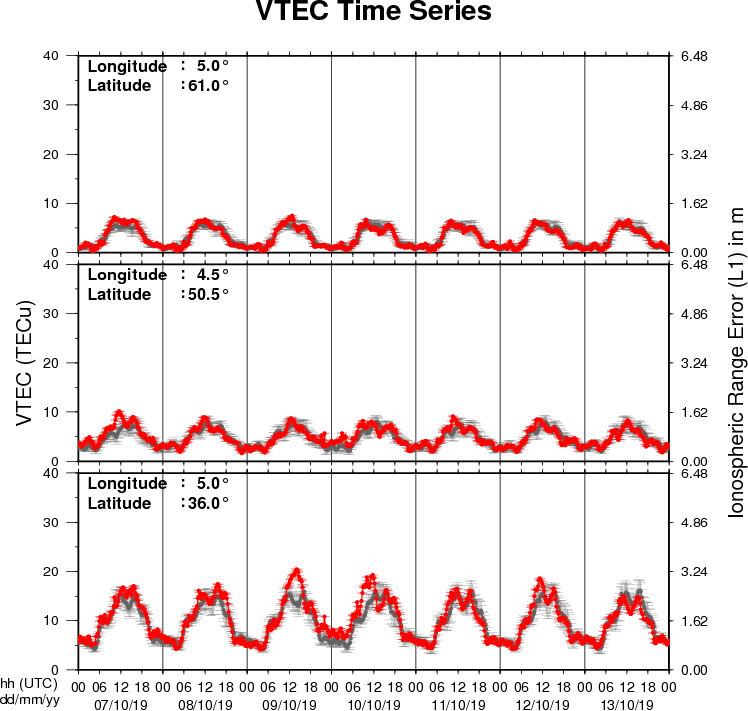
The figure shows the time evolution of the Vertical Total Electron Content (VTEC) (in red) during the last week at three locations:
a) in the northern part of Europe(N61°, 5°E)
b) above Brussels(N50.5°, 4.5°E)
c) in the southern part of Europe(N36°, 5°E)
This figure also shows (in grey) the normal ionospheric behaviour expected based on the median VTEC from the 15 previous days.
The VTEC is expressed in TECu (with TECu=10^16 electrons per square meter) and is directly related to the signal propagation delay due to the ionosphere (in figure: delay on GPS L1 frequency).
The Sun's radiation ionizes the Earth's upper atmosphere, the ionosphere, located from about 60km to 1000km above the Earth's surface.The ionization process in the ionosphere produces ions and free electrons. These electrons perturb the propagation of the GNSS (Global Navigation Satellite System) signals by inducing a so-called ionospheric delay.
See http://stce.be/newsletter/GNSS_final.pdf for some more explanations ; for detailed information, see http://gnss.be/ionosphere_tutorial.php
